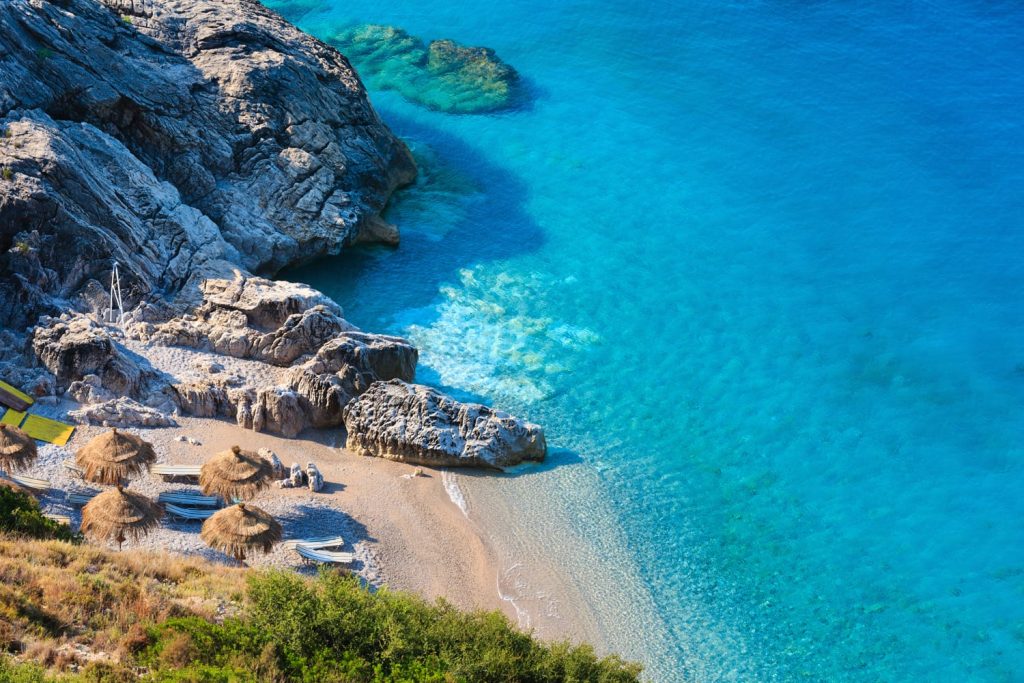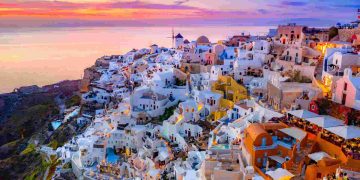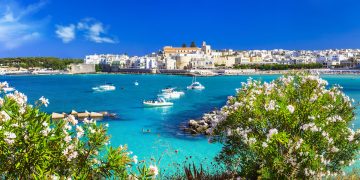Introduction
In the Mediterranean, few names are as synonymous with idyllic beauty and luxury as Santorini, the famous Greek island known for its whitewashed buildings, crystal-clear waters, and unforgettable sunsets. However, just a few hundred kilometers away lies a lesser-known gem—Saranda, a small coastal town in southern Albania. While Saranda may not yet boast the fame and recognition of Santorini, its potential to become “the next Santorini of Europe” has been gaining attention in recent years. With its pristine beaches, rich history, and growing tourism industry, many experts and visitors alike are wondering: will Saranda rise to the level of one of Europe’s most coveted destinations?
This article explores Saranda’s appeal, its current status as a rising tourist destination, and whether it truly has what it takes to become Europe’s next Santorini.
Saranda: A Hidden Gem on Albania’s Ionian Coast
Saranda is located along Albania’s Ionian coastline, facing the crystal-clear waters of the Ionian Sea. Historically, the town has always been an important cultural and economic hub for the region. Once a quiet, modest fishing village, it has blossomed into a rapidly growing tourist hotspot. While many tourists are still unaware of its beauty, Saranda’s profile is steadily rising due to its unspoiled nature, charming Mediterranean architecture, and proximity to other iconic destinations in Albania, such as the UNESCO World Heritage site of Butrint and the pristine beaches of Ksamil.
The Allure of Santorini: What Makes It Special?
Before diving into Saranda’s potential, it’s important to understand why Santorini has become one of Europe’s most coveted tourist destinations. Santorini is renowned for several key features:
- Iconic Architecture: The white-washed buildings with blue domes that overlook the Aegean Sea.
- Breathtaking Views: The island’s caldera provides panoramic views of the turquoise waters and dramatic cliffs.
- Rich History: Santorini’s archaeological sites, such as the ancient city of Akrotiri, provide insight into the island’s rich Minoan past.
- Vibrant Culture: The island’s food, wine, and unique local customs create a culturally immersive experience for visitors.
While Saranda may not yet rival Santorini in terms of global fame, its natural beauty and emerging tourist infrastructure have many wondering if it could eventually follow a similar trajectory.
Comparing Saranda to Santorini
1. Natural Beauty and Geography
Saranda offers a landscape that is comparable in beauty to that of Santorini. Its beaches are among the most beautiful in the Mediterranean, with crystal-clear waters and secluded coves. Unlike Santorini, which is volcanic, Saranda has a more varied landscape, with lush hills and a picturesque coastline dotted with small islands.
While Santorini’s caldera offers dramatic cliffs and views of an active volcano, Saranda’s appeal lies in its softer, Mediterranean charm. The town’s proximity to the Albanian Riviera means it has access to some of the most unspoiled beaches in Europe, such as Ksamil Beach, which has been called one of Europe’s hidden treasures.
2. Cultural and Historical Significance
Santorini’s history dates back to ancient times, with the volcanic eruption that destroyed the Minoan civilization in the 17th century BC being a defining event in its cultural story. The archaeological ruins of Akrotiri continue to draw visitors from around the world.
Saranda, too, boasts a rich cultural history, although it may not be as well-known internationally. The nearby ancient city of Butrint, another UNESCO World Heritage site, is a testament to the region’s historical significance. Dating back to the 7th century BC, Butrint was once a Greek and Roman city and offers a wealth of archaeological treasures for history buffs.
3. Tourism Infrastructure
Santorini has been a major tourist destination for decades. Its infrastructure is well-developed, with luxury resorts, fine dining establishments, and world-class shopping. The island’s tourism industry supports a steady flow of visitors, ranging from honeymooners to cruise ship passengers.
Saranda, in contrast, is still developing its tourism infrastructure. The town offers a mix of budget-friendly accommodations and mid-range hotels, and although high-end resorts are starting to appear, it remains a more affordable destination. In recent years, there has been a surge in investment in Saranda’s hotels, restaurants, and transportation options, but it still lags behind Santorini in terms of luxury offerings.
4. Accessibility
Santorini is well-connected by air and sea, with daily flights from major European cities and numerous ferry connections from other Greek islands. It is a hub for cruise ships, and the island’s port sees thousands of visitors each day.
Saranda is also becoming increasingly accessible. The town is connected to the Albanian capital, Tirana, via a new highway, and the nearby Corfu International Airport in Greece makes it easy for travelers from across Europe to reach the town. Additionally, the Albanian government has invested in improving the country’s overall infrastructure, including roads and ports, making it easier to visit Saranda.

The Growing Popularity of Saranda
Saranda has been experiencing a tourism boom in recent years, attracting more visitors each season. This growth is largely driven by its affordable prices, stunning natural beauty, and the ease of access from nearby Greece. While it may not yet be on the same level as Santorini, the town’s allure is undeniable.
1. The Rise of the Albanian Riviera
Saranda is part of the Albanian Riviera, a stretch of coastline that has recently gained attention for its unspoiled beauty and low-cost luxury. As more tourists seek out alternatives to the overcrowded beaches of Italy and Greece, Albania has become an attractive option. Saranda, as one of the most developed towns along the Riviera, is poised to benefit from this growing interest.
2. Luxury Tourism Investment
In response to the influx of visitors, many investors are beginning to pour money into the town’s luxury tourism sector. New hotels, resorts, and high-end restaurants are opening, catering to the growing demand for premium accommodations. However, the challenge for Saranda will be to maintain a balance between development and preserving the town’s natural charm, which is one of its biggest selling points.
3. Environmental Concerns
As tourism continues to grow, so do concerns about the environmental impact. Saranda’s beaches and surrounding nature are some of its biggest draws, and there is a risk that mass tourism could degrade the environment. The Albanian government and local businesses will need to work together to ensure that tourism is sustainable and does not harm the natural beauty that makes Saranda so special.
Will Saranda Become the Next Santorini?
While Saranda’s potential is clear, whether it can truly become the next Santorini is still uncertain. The town’s natural beauty and proximity to historical landmarks, combined with its growing tourism infrastructure, make it a strong contender. However, several factors will determine whether Saranda can reach the same level of fame and prestige as Santorini:
- Maintaining its Authenticity: One of the key aspects of Santorini’s appeal is its authentic Greek charm. Saranda must strike a balance between development and preservation to avoid becoming too commercialized.
- Continued Investment: In order to compete with established destinations like Santorini, Saranda will need significant investment in luxury accommodations, fine dining, and high-quality attractions. Additionally, the government must ensure that infrastructure improvements are sustainable and environmentally friendly.
- Marketing and Branding: Santorini’s worldwide recognition did not happen overnight. It took decades of effective branding and marketing to build the island’s reputation. Saranda will need a similar strategy to elevate its profile on the global tourism stage.
- Cultural and Historical Recognition: Just as Santorini capitalized on its archaeological sites and unique culture, Saranda must continue to promote its own rich history, including the ancient ruins of Butrint and the town’s traditional Albanian heritage.
Conclusion
Saranda’s future is bright, and its potential to become a major European tourist destination is undeniable. With its stunning landscapes, rich history, and growing infrastructure, Saranda has all the ingredients to follow in the footsteps of Santorini. However, it will require careful management, strategic investment, and a commitment to preserving its natural charm. Whether Saranda can become the next Santorini will depend on how it balances development with sustainability, all while capturing the imagination of travelers from around the world.
For now, Saranda remains one of Europe’s best-kept secrets—whether it stays that way or evolves into the next Mediterranean hotspot remains to be seen. But one thing is certain: this Albanian gem is definitely worth keeping an eye on in the years to come.





















